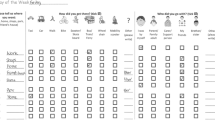Abstract
People with vision impairments (PVIs) have inferior physical fitness compared to sighted individuals. Several studies have been conducted to understand concerns, motivations, barriers, and experiences with exercise in the blind population. However, these studies have been limited to the developed regions. India is home to one-third of the world’s blind population and hence it is crucial to understand exercise patterns among PVIs in India. In this work, we interviewed 24 Indian PVIs to uncover novel insights, including minimal use of exercise technology, crucial role of blind schools, and infrastructural and social barriers. We conclude the paper with design recommendations, such as exploiting the design space of restricted walking, emphasizing on schools for the blind, and forming support groups to promote exercises among PVIs.
Access this chapter
Tax calculation will be finalised at checkout
Purchases are for personal use only
Similar content being viewed by others
References
CDC: How much physical activity do adults need? (2019). https://www.cdc.gov/physicalactivity/basics/adults/index.htm
Çolak, T., Bamaç, B., Aydin, M., Meriç, B., Özbek, A.: Physical fitness levels of blind and visually impaired goalball team players. Isokinetics Exerc. Sci. 12(4), 247–252 (2004)
Correspondent, H.: Number of blind to come down by 4m as india set to change blindness definition (2017). https://bit.ly/3aXHKB7
Dawn, R.: The portrayal of disability in Indian culture: an attempt at categorization (01 2015)
Dwyer, A.: Factors That Increase Physical Activity in Youth Who Are Visually Impiared. Kinesiology, Sport Studies, and Physical Education Synthesis Projects (May 2017). https://digitalcommons.brockport.edu/pes_synthesis/22
Hopkins, W.G., Gaeta, H., Thomas, A.C., Hill, P.N.: Physical fitness of blind and sighted children. Eur. J. Appl. Phys. Occup. Phys. 56(1), 69–73 (1987). https://doi.org/10.1007/BF00696379
India, G., Jain, M., Karya, P., Diwakar, N., Swaminathan, M.: VStroll: An audio-based virtual exploration to encourage walking among people with vision impairments. In: ASSETS 2021, ACM (October 2021). https://doi.org/10.1145/3441852.3471206
India, G., Ramakrishna, G., Pal, J., Swaminathan, M.: Conceptual learning through accessible play: Project Torino and computational thinking for blind children in India. In: ICTD 2020 (June 2020)
Kumar, P.: Evolving role of special schools for children with visual impairment in India (2019). https://ncert.nic.in/pdf/publication/journalsandperiodicals/journalofindianeducation/JIE_May_18.pdf
Lieberman, L.J., McHugh, E.: Health-related fitness of children who are visually impaired. J. Vis. Impairment Blindness 95(5), 272–287 (2001). https://doi.org/10.1177/0145482X0109500503
Morelli, T., Foley, J., Columna, L., Lieberman, L., Folmer, E.: Vi-tennis: a vibrotactile/audio exergame for players who are visually impaired. In: FDG 2010, New York, pp. 147–154. ACM (2010). https://doi.org/10.1145/1822348.1822368
Morelli, T., Foley, J., Folmer, E.: Vi-bowling: a tactile spatial exergame for individuals with visual impairments. In: ASSETS 2010, New York, pp. 179–186. ACM (2010). https://doi.org/10.1145/1878803.1878836
Morelli, T., Foley, J., Lieberman, L., Folmer, E.: Pet-n-punch: upper body tactile/audio exergame to engage children with visual impairments into physical activity, presented at the. In: Proceedings of Graphics Interface 2011 (2011)
NAB: Nan department of education (2019). https://www.nabindia.org/education/
Rector, K., Bennett, C.L., Kientz, J.A.: Eyes-free yoga: An exergame using depth cameras for blind amp; low vision exercise. In: ASSETS 2013, New York, ACM (2013). https://doi.org/10.1145/2513383.2513392
Rector, K., Milne, L., Ladner, R.E., Friedman, B., Kientz, J.A.: Exploring the opportunities and challenges with exercise technologies for people who are blind or low-vision. In: ASSETS 2015, New York, pp. 203–214. ACM (2015). https://doi.org/10.1145/2700648.2809846
Stuart, M.E., Lieberman, L., Hand, K.E.: Beliefs about physical activity among children who are visually impaired and their parents. J. Vis. Impairment Blindness 100(4), 223–234 (2006). https://doi.org/10.1177/0145482X0610000405
UNESCO: N for nose: State of the education report for India 2019: Children with disabilities (2019). https://en.unesco.org/news/n-nose-state-education-report-india-2019-children-disabilities
View, S.: Where do children who are blind or visually impaired go to school? (2015). https://sandysview1.wordpress.com/2015/06/04/where-do-children-who-are-blind-or-visually-impaired-go-to-school/
Weil, E.: Obesity among adults with disabling conditions. JAMA 288(10), 1265 (2002). https://doi.org/10.1001/jama.288.10.1265
Wikipedia: Classification of Indian cities (2020). https://en.wikipedia.org/wiki/Classification__of_Indian_cities
Williams, C., Armstrong, N., Eves, N., Faulkner, A.: Peak aerobic fitness of visually impaired and sighted adolescent girls. J. Vis. Impairment Blindness 90(6), 495–500 (1996)
Yuan, B., Folmer, E.: Blind hero: Enabling guitar hero for the visually impaired. In: ASSETS 2008, New York, pp. 169–176. ACM (2008). https://doi.org/10.1145/1414471.1414503
Zhu, Y., Wang, C., Liu, W., Lv, Y.: Running guide: Design of a marathon navigation system for visually impaired people. In: Chinese CHI 2019, New York, pp. 7–15. ACM (2019). https://doi.org/10.1145/3332169.3333579
Author information
Authors and Affiliations
Editor information
Editors and Affiliations
A Codebook
A Codebook
Rights and permissions
Copyright information
© 2021 IFIP International Federation for Information Processing
About this paper
Cite this paper
India, G., Jain, M., Swaminathan, M. (2021). Understanding Motivations and Barriers to Exercise Among People with Blindness in India. In: Ardito, C., et al. Human-Computer Interaction – INTERACT 2021. INTERACT 2021. Lecture Notes in Computer Science(), vol 12932. Springer, Cham. https://doi.org/10.1007/978-3-030-85623-6_27
Download citation
DOI: https://doi.org/10.1007/978-3-030-85623-6_27
Published:
Publisher Name: Springer, Cham
Print ISBN: 978-3-030-85622-9
Online ISBN: 978-3-030-85623-6
eBook Packages: Computer ScienceComputer Science (R0)





